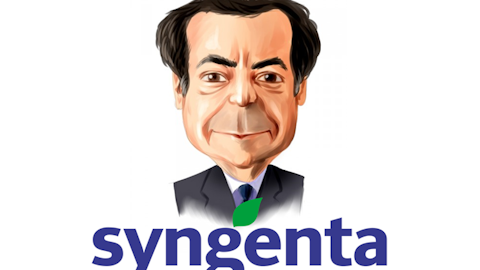Monsanto Company (NYSE:MON) announced its decision to abandon a $46.5 billion hostile bid for Swiss competitor Syngenta AG (NYSE:SYT) this morning. The shares of the former are 6.82% in green at the time of writing, while the shares of the latter have lost over 15% so far in today’s trading session. Even though Bloomberg reported yesterday that the St. Louis-based agricultural company had raised its bid for Syngenta, Monsanto failed to meet the financial expectations of the target and decided to put an end to its pursuit. Monsanto will instead focus on the existing opportunities within its core business and go back to the implementation of its previously-approved share repurchase program. Even more to that, the company expressed its belief that its five-year plan to more than double the previous year’s earnings per share by the year 2019 is highly likely to be successful. Meanwhile, it is no surprise why the shares of Syngenta dropped by so much today; the differential between the target’s acquisition price and its current trading price is expected to widen quite significantly, as some players on the market naturally attempted to benefit from the merger talks and the possibility of a deal.

Let’s first take a step back and analyze how tracking hedge funds can help an everyday investor. Through our research we discovered that a portfolio of the 15 most popular small-cap picks of hedge funds beat the S&P 500 Total Return Index by nearly a percentage point per month on average between 1999 and 2012. On the other hand the most popular large-cap picks of hedge funds underperformed the same index by seven basis points per month during the same period. This is likely a surprise to many investors, who think of small-caps as risky, unpredictable stocks and put more faith (and money) in large-cap stocks. In forward tests since August 2012 these top small-cap stocks beat the market by an impressive 60.4 percentage points, returning 118% (read the details here). Follow the smart money into only their best investment ideas all while avoiding their high fees.
Monsanto Company provides agricultural products worldwide and operates in two segments: Seed and Genomics, and Agricultural Productivity. Although the shares of Monsanto are in the green today, the stock is still down by nearly 20% year-to-date. On the other hand, Syngenta is also an agribusiness company, that engages in the discovery, development, manufacturing, and marketing of a wide range of products designed to increase crop yields and food quality. Syngenta’s shares are currently trading at relatively the same level as they were trading at the beginning of the year.
A total of 64 hedge funds tracked by Insider Monkey held long positions in Monsanto Company (NYSE:MON) at the end of the second quarter, ten funds more quarter-over-quarter. At the same time, the value of these positions rose to $3.54 billion from $2.95 billion. In the meantime, there are 16 hedge funds within our database that held equity stakes in Syngenta AG (NYSE:SYT) at the end of the second quarter, compared to nine funds a quarter ago. Nevertheless, the value of the stakes decreased to $37.19 million from $63.26 million over the same period, even as the stock soared during the period on news of the hostile takeover attempt, suggesting that many funds with long positions sold out following the gains, while many event-driven funds entered it with minimal positions.
When looking at the hedge funds followed by Insider Monkey, Larry Robbins’ Glenview Capital held the most valuable position in Monsanto at the end of the second quarter. Glenview Capital owned 11.07 million shares of the company as of June 30, which accounted for 4.67% of its portfolio. At the same time, Fir Tree, which is also among the largest shareholders of Monsanto, boosted its stake in the company to 2.28 million shares during the recent quarter. Moving on to the former “target”, Israel Englander’s Millennium Management was the largest equity holder in Syngenta AG (NYSE:SYT) with 132,060 shares.
To sum up, if anyone is considering holding one of the two stocks over a long-term spectrum, we would suggest to wait until the turmoil around the freshly-failed deal wipes out.
Disclosure: None





